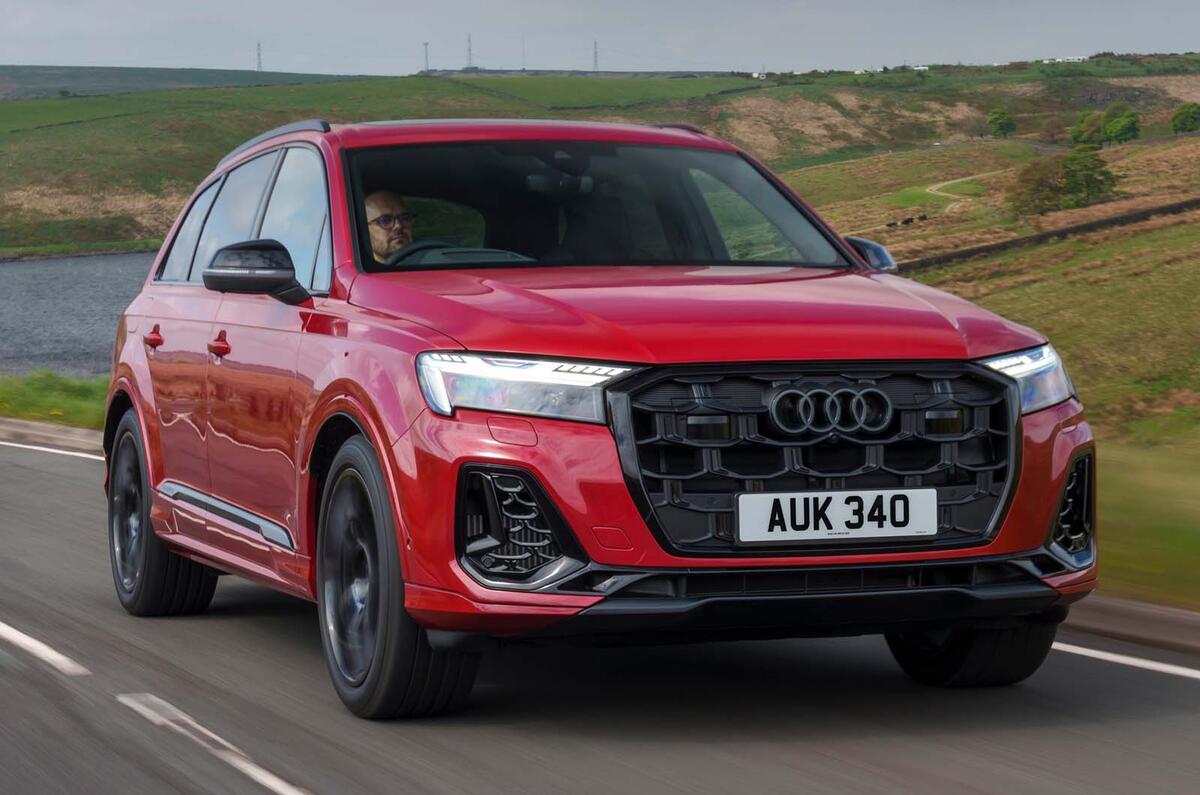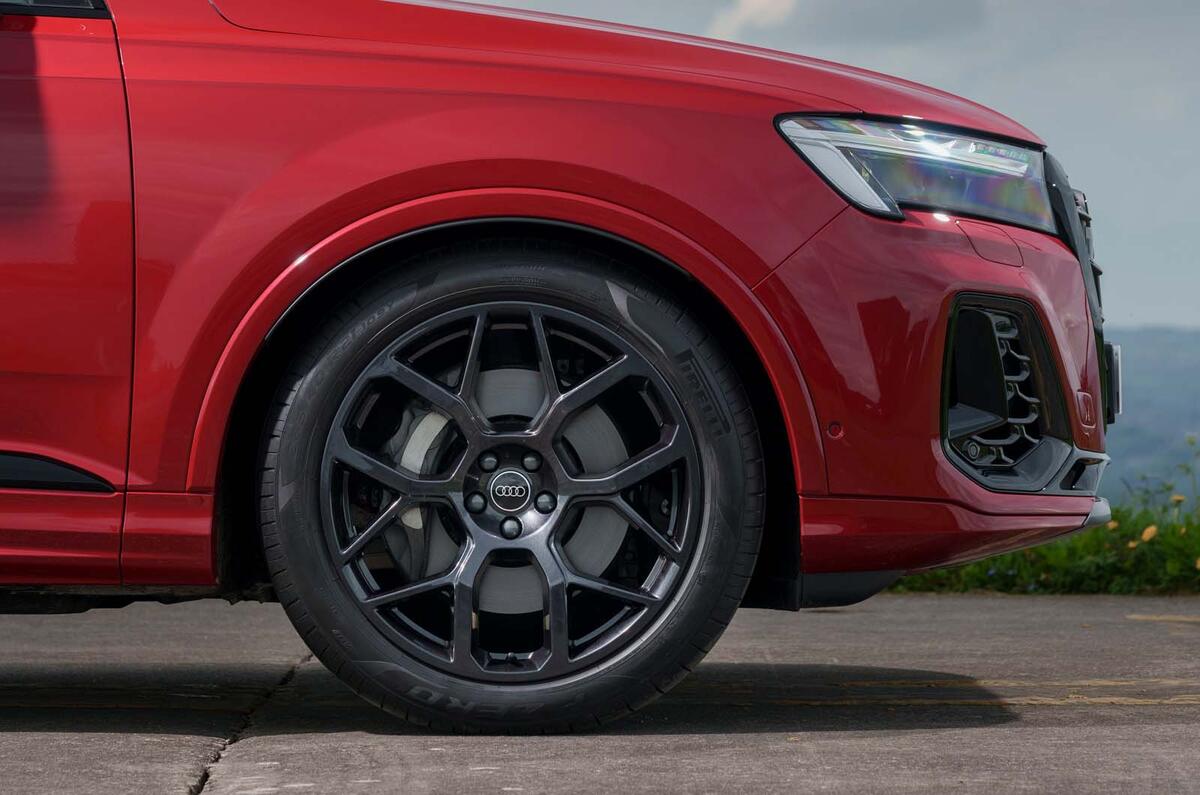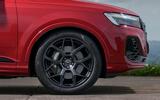Audi Q7 review
From £66,6908
Ingolstadt’s flagship SUV has been given a fresh new look and upgraded tech – but what is it like to drive?

Published:
17 April 2025
- Introduction
- Design & styling
- Interior
- Engines & performance
- Ride & handling
- MPG & running costs
- Verdict
- Prices & specs
Find a car reviewMakeAbarthAC CarsAC SchnitzerAehraAircraft carrierAiwaysAlfa RomeoAllardAlpinaAlpineAnalogue AutomotiveArielAscariAston MartinAudiBACBentleyBeyonCaBizzarriniBMWBorgwardBowlerBrabusBristolBrookeBugattiBYDBytonCadillacCallawayCampagnaCaparoCaterhamCatonChangan AutoChevroletChryslerCitroenCooper (2001-2006)CupraDaciaDaewooDaihatsuDallaraDavid BrownDe TomasoDeLoreanDenzaDodgeDonkervoortDSDysonEagleElectrogenicElementalElfinEternitiFarbioFerrariFiatFiskerFordGBSGeelyGenesisGinettaGMCGordon Murray AutomotiveGreat British Sports CarsGreat WallGT LE50GTO EngineeringGumpertGunther WerksGWMHennesseyHiPhiHispano SuizaHoldenHondaHongqiHuman HorizonsHummerHyundaiIFRIneosInfinitiInvictaIsuzuItalDesignIvecoJaecooJaguarJannarellyJCBJeepJIAKamm ManufakturKen OkuyamaKGMKiaKimeraKingsley CarsKoenigseggKTMLadaLamborghiniLanciaLand RoverLeading EdgeLeapmotorLEVCLexusLightyearLincolnLMCLotusLucidLynk & CoMahindraMarcosMarlinMaseratiMastrettaMaxusMaybachMazdaMcLarenMercedes-AMGMercedes-BenzMercedes-MaybachMG MotorMiaMicroMikaMiniMitsubishiMitsuokaMK SportscarsMobilizeMorganMS-RTMSTMunroMurrayNextEVNioNissanNobleOldsmobileOmodaOpelPaganiPaul StephensPembleton Motor CompanyPeroduaPeugeotPininfarinaPolarisPolestarPorschePragaProdriveProtonQorosRadfordRadicalRamRed BullRenaultRevologyRevolutionRimacRiversimpleRivianRMLRodinRoeweRolls-RoyceRoverRS6 GTRufSaabSaturnScoutSeatSenovaShelbySilenceSinSkodaSkywellSmartSmit OlethaSpartan Motor CompanySpykerSRTSsangyongSSCSubaruSuperformanceSuzukiTataTeslaTheon DesignTigerTolmanToniqTouring SuperleggeraToyotaTriumphTushekTVRTwistedUniqueVauxhallVencerVeritasVinfastVolkswagenVolvoVoyahVuhlWellsWestfieldWiesmannXiaomiXpengYangwangZeal MotorZeekrZenosZenvoZolfeZoyteModel
- Introduction
- Design & styling
- Interior
- Engines & performance
- Ride & handling
- MPG & running costs
- Verdict
- Prices & specs
Find Audi Q7 deals

Nearly-new car dealsFrom £54,009
Other Services

Versatile, practical and refined: these words have often been used to describe the Audi Q7, the firm’s long-standing, flagship large SUV.
Ingolstadt’s unashamedly luxury 4×4 launched in 2007, and was dramatically reinvented for its second-generation in 2015 before being treated to a hefty facelift in 2020.
Last year, the Q7 went under the knife yet again in a last gasp push for sales before the third-generation model lands in 2026, which will likely be one of the last new Audis to launch with combustion power.
Audi is hoping that the latest update, which has brought a number of styling tweaks and new technology, will help it to fend off a broad range of rivals like the Land Rover Defender, BMW X5 and new Volvo XC90, not to mention upcoming electric competitors like the Kia EV9 and inbound Hyundai Ioniq 9.
But as Audi seeks to broaden its electric ambitions with a raft of e-tron-badged models and bolsters its range of hybridised cars before it turns to batteries for good, is the brand’s loyal large SUV still a front-runner in its class? Let’s find out.
https://www.drivenbuy.co.uk/autocar?car_make=audi&car_model=q7&review=new&source=https://www.autocar.co.uk/car-review/audi/q7
Verdict

Model tested:
Rating: 8
Audi Q7
Audi’s flagship SUV is as practical and refined as ever, but its PHEV credentials limit its capabilities as a large SUV
Good
Outstanding cabin refinement
Towering material quality
Roomier than most seven-seat SUVs
Bad
Remote, assistance-heavy steering
No handling finesse
PHEV range still can’t match rivals
DESIGN & STYLING
Pros
PHEV gets a larger battery for improved EV range
Broad mix of engines with petrol, diesel and hybrid all on offer
Cons
Facelift is refreshing but overall design is starting to fall behind new-gen rivals
PHEV is heavier than ICE counterparts and doesn’t come with seven-seats
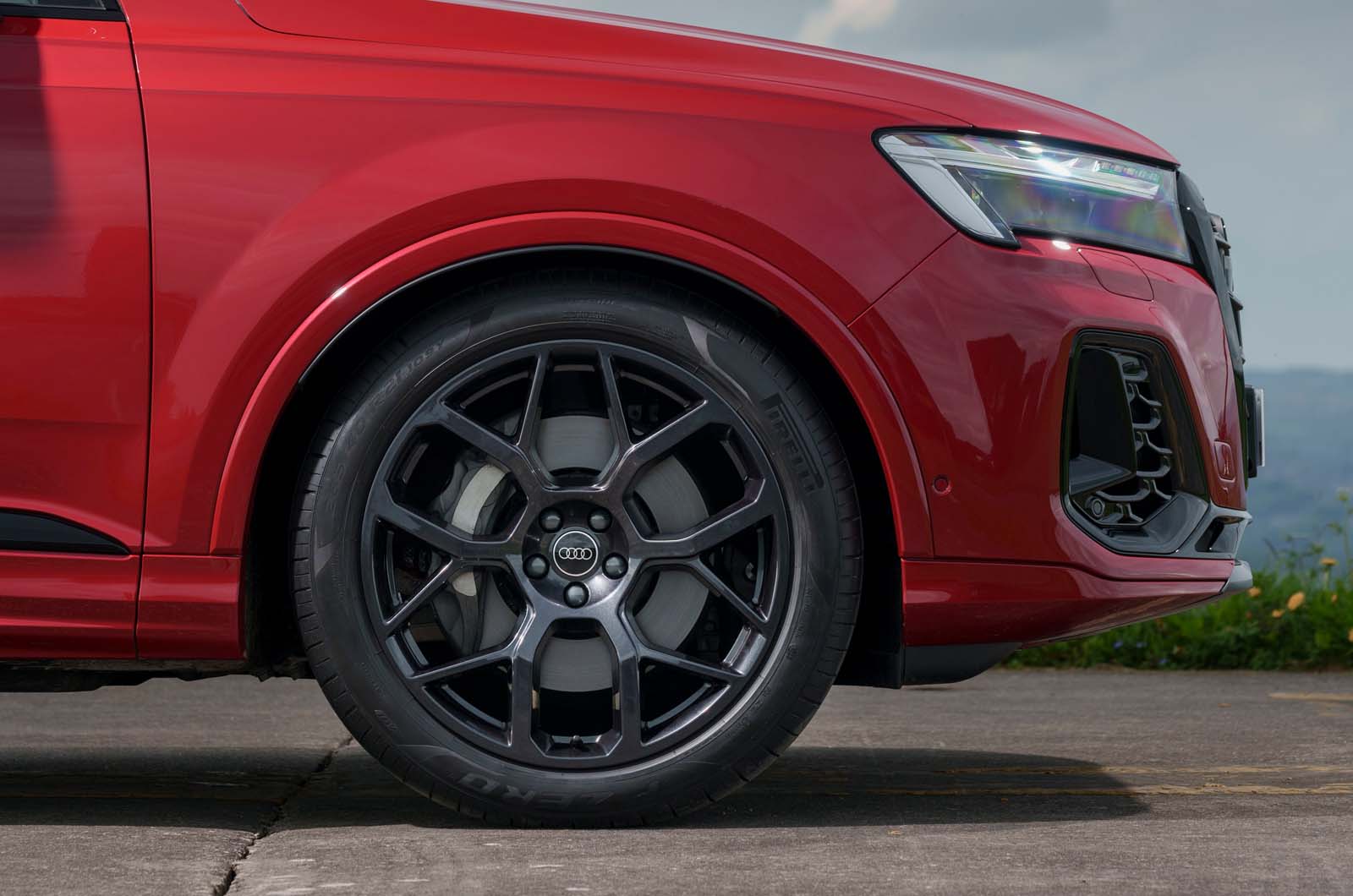
The Q7’s latest nip and tuck is modest at best, with the large SUV gaining new front and rear bumpers, a new front radiator grille and fancier Matrix LED.
There’s a couple of new paint and wheel options, too, but S-Line, Black Edition and Vorsprung trims are still present.
Audi hasn’t touched the engine and trim line-up, which means UK buyers are still offered the same broad mix of petrol, diesel and plug-in hybrid engines.
Opening the line-up is the 45 TDI, which uses a 3.0-litre diesel V6 which makes 227bhp and 368 lb ft of torque. Then there’s the 55 TDI which uses the same V6 engine but has a slightly higher output of 282bhp and 74 lb ft more torque.
In the petrol corner there’s the 55 TFSI, which gets 335bhp 3.0-litre V6 that cuts the 0-60mph time to 5.6sec. Expect more trips to the pumps though – average economy is claimed to be around the 26mpg mark.
If you’re willing to sacrifice fuel economy even more, and want your family SUV to be seriously quick, then the range-topping SQ7 will quench your thirst for horsepower. Its 500bhp twin-turbocharged V8 will thrust it along to 60mph in just 4.1sec – that’s quicker than the Land Rover Defender V8 and Mercedes-AMG GLS 63.
You can also have a 55 TFSIe plug-in hybrid variant, like our test car, which pairs the same V6 petrol engine from the 55 with an electric motor to make 389bhp. While its predecessor used a 17.9kWh battery for an electric range of around 27 miles, the current model gets a larger 25.9kWh battery that has upped the zero emission range to a more competitive 51 miles.
All Q7s come with four-wheel drive, an eight-speed automatic gearbox and 48V mild-hybrid technology.
INTERIOR
Pros
Premium cabin majors on quality, refinement and technology
Space and practicality are both in strong supply
Virtual cockpit is crisp and endlessly customisable
Cons
Small buttons on screens means you have to take your eyes of the road
No physical buttons for the climate controls
Small boot and no third row in PHEV
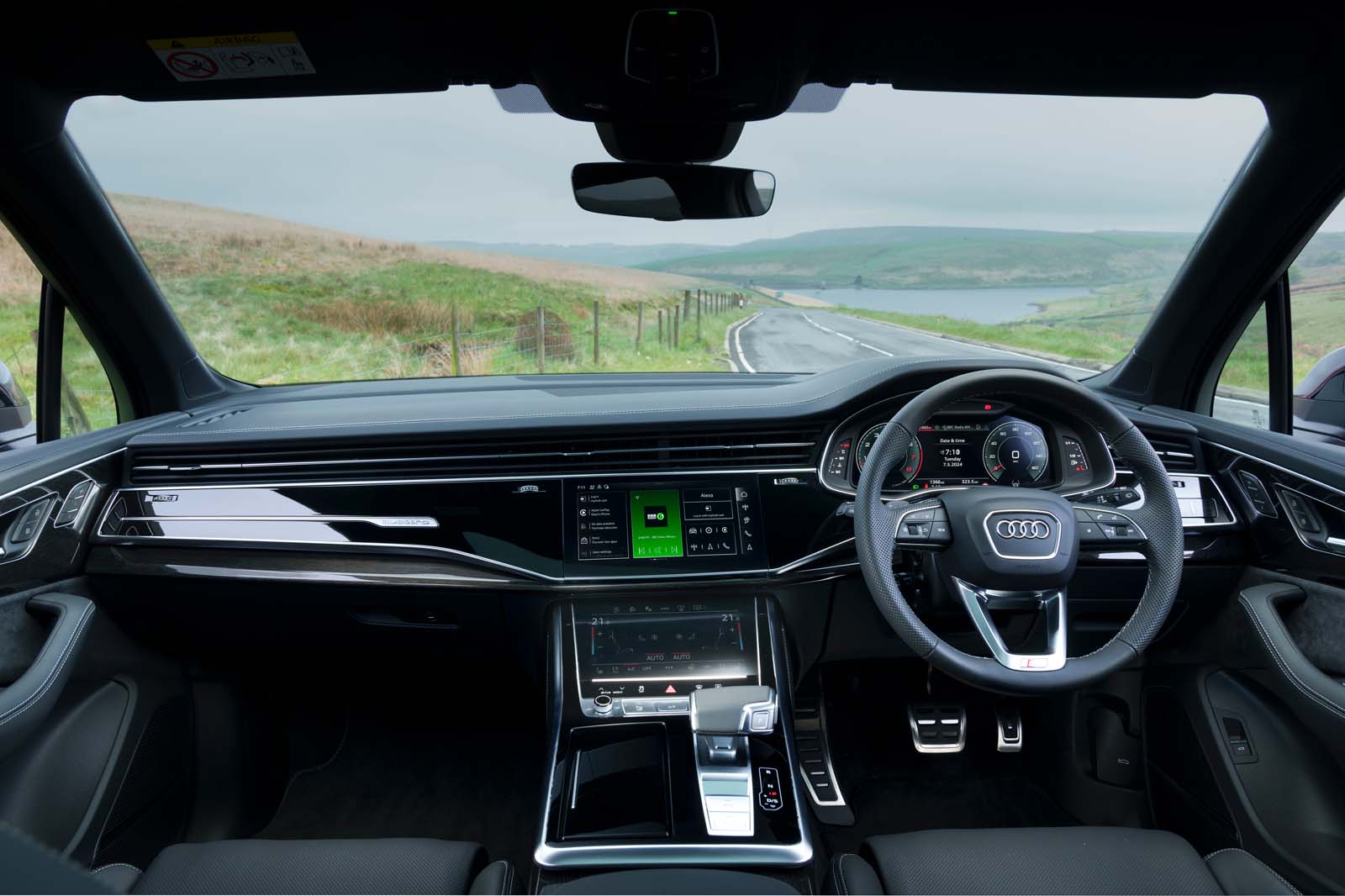
Little else showcases the Q7’s quality and refinement more than its lavishly appointed cabin.
Rivals like the Range Rover Sport and BMW X5 have long been at the forefront when it comes to modern luxury interiors but the Audi is more than up to the challenge.
The two touchscreen and black trim look smart but leave plenty of finger prints when the car is turned off.
Its preference for brushed metal (or the appearance of it), sweeping lines, supreme fit and finish, plush leathers and suede inserts in the doors give it a classy feel that isn’t garish or over-the-top. Even the cheaper plastics lower down by your feet feel are of high quality.
There isn’t a surface or item of switchgear that doesn’t commend itself to the touch, and the two-tier screens (one for the infotainment and the other for the climate controls) are neatly integrated into the dash.
That being said, the screens themselves aren’t the best in terms of responsiveness and configuration. Some of the icons are a little too small, which means you’re forced to look away from the road to make sure you hit it with your finger accurately.
It’s the same story with the lower display for the climate controls: the buttons are perhaps less fiddly, but a lack of physical switches and knobs makes it a little harder to operate while driving.
Still, both screens benefit from a number of larger shortcut buttons and it’s easy to pair your phone via Apple Carplay or Android Auto, which you’ll likely use most of the time.
Audi’s super-sharp Virtual Cockpit display is one of the best out there and its customisation and flexibility is second to none. You can view all kinds of economy data or you can turn the entire display into one giant sat-nav screen. The head-up display in our test car was good, too.
Beyond the tech and materials, the Q7 is supremely spacious and practical. There is more than enough room for tall adults in the second row which has three individual seats that can all slide fore and aft.
If you opt for the plug-in like our test car, you lose the third row of seats and the boot capacity drops from 780-litres to 563-litres due to the battery being stored in the floor.
The Q7 is still a model of practicality, but choose your engine wisely if you’re in need of a third row of seats and more boot space.
ENGINES & PERFORMANCE
Pros
Plug-in hybrid feels brisk, smooth and relaxing with a decent turn of pace
Excellent rolling refinement
Cons
Quite a lot of confusing powertrain modes
Brake pedal could have more feel
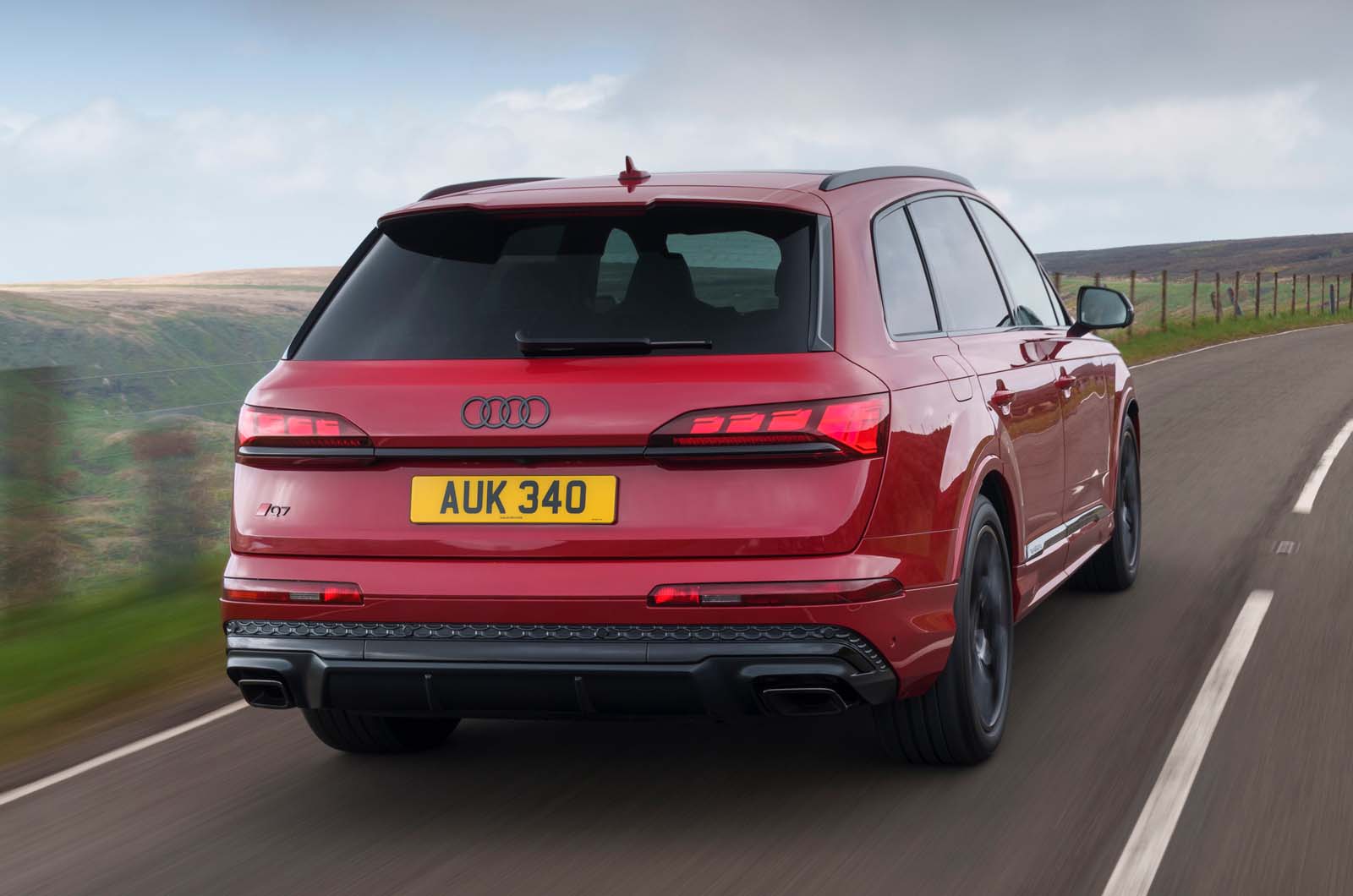
With 389bhp and 442lb ft of torque, there is more than enough performance to thrust the plug-in Q7 along in a smooth and relaxing manner.
The 0-62mph sprint takes 5.7sec and it feels pretty brisk for a car that weighs close to 2500kg and has a near 3.0m wheelbase.
Jump on the throttle and the Q7 feels spritely and responsive; take a more laid back approach and its relaxing, and settles into a cruise nicely.
The hybrid powertrain features two different modes: Auto, which is the most efficient way of getting from A to B as it chooses the best power source for you. Hold keeps the battery charged by feeding energy back into the pack via regenerative braking.
When you pull away the Q7 starts in EV mode, before swapping to hybrid mode when you’re after more grunt or when the battery is depleted. You rarely notice when the engine chimes up to deliver extra support: it’s all very smooth and the electric motor fills in the gaps in torque well.
In pure EV mode the Q7 is pleasant and refined, and it’s more than up to the task for hauling the car around rural backroads and for mooching around town.
There’s some character to the petrol V6 engine when you ask for all of its horses, and the eight-speed gearbox shifts in a typically well mannered fashion.
We’d have a liked a bit more feel from the brake pedal, especially when the car is harvesting energy as you’re coasting. You won’t notice it too much, but when the car is actively slowing the car down via regenerative braking, the pedal can feel a bit long making it harder to modulate.
It’s impeccably hushed and refined, however, with the audible presence of the engine and the intrusion of road and wind noise reduced to a murmur.
RIDE & HANDLING
Pros
Adaptive suspension isolates you from severe potholes and imperfections
Relaxing over long distances
Cons
Ride slightly unsettled at lower speeds
Steering lacks feel and is less engaging than rivals
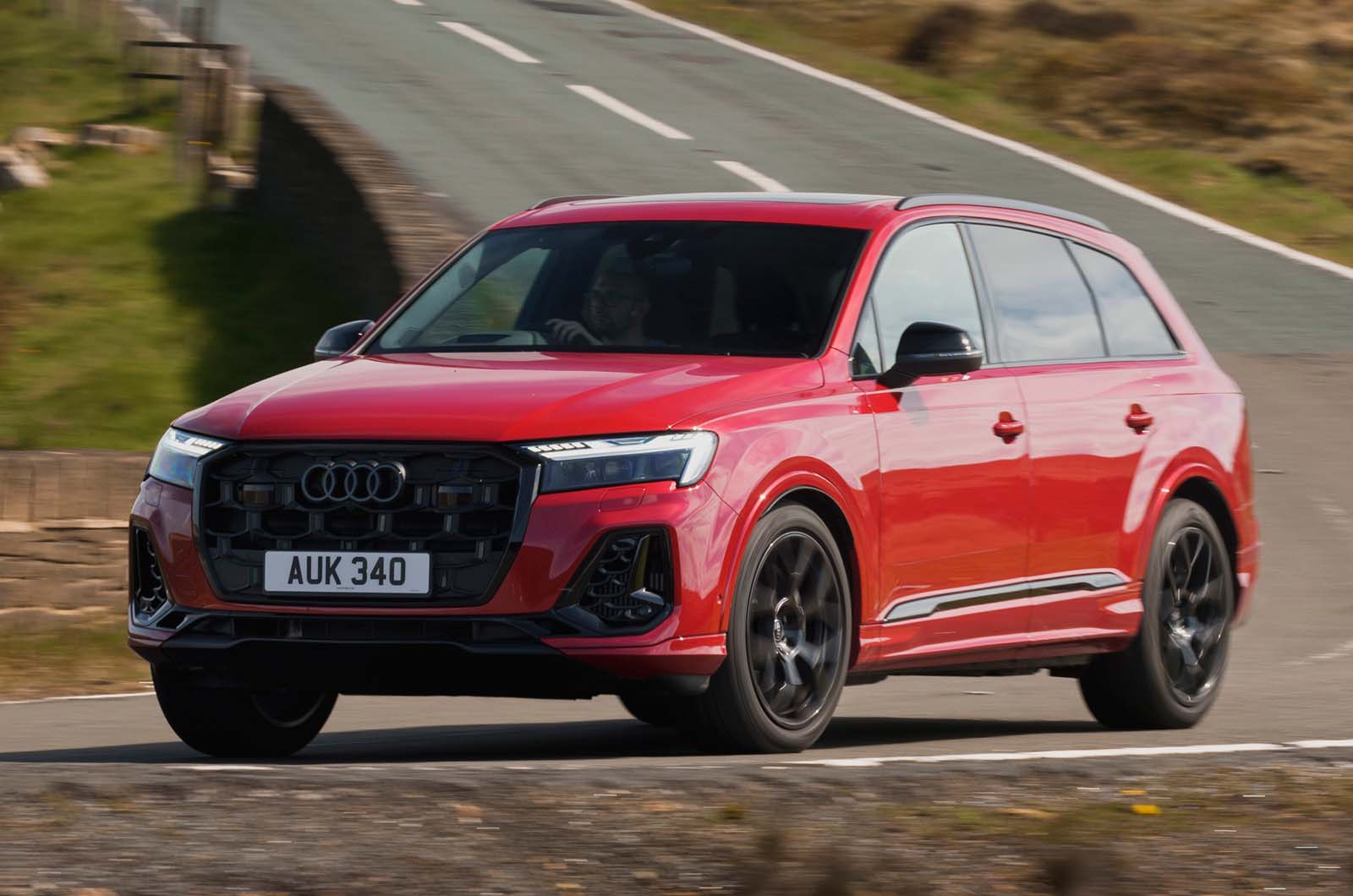
The biggest mark against the hybrid Q7 is the extra 345kg of mass it carries compared to its diesel rangemates.
It’s a heavy car, and it doesn’t disguise its bulk and heft quite as well as its plug-in rivals. Through mid-speed corners on a cross country road, there is plenty of body roll, and you can feel the weight trying to catch up with you.
The Q7 is indeed more settled when you exercise caution and there’s less vertical body movements when you’re simply pootling along.
The steering feels a bit remote, however, and you have to apply more lock that you might have originally thought necessary.
While rivals like the BMW X5 and Range Rover Sport manage to hide their mass thanks to their responsive steering, the Audi falls some way short. The quick response of the Q7’s rack makes it feel less linear and there isn’t much feel off centre.
That means that while it’s precise and relaxing to drive, rivals are just a bit easier to place on the road and more engaging to drive when you’re driving spriritedly.
Engaging handling was unlikely to be high on Audi’s wish list anyway, and its cruise-ability and comfortable ride make up for any dynamic shortcomings.
On the motorway it is supple and untroubled by road imperfections and potholes. Our TFSIe test car was fitted with 20in wheels and adaptive air suspension.
While it generally soaked up lumps and bumps well, there was the odd niggle in the ride over pockmarks and expansion joints, particularly at lower speeds.
Overall, this is a comfortable SUV and one that you’ll enjoy driving a long distance, just don’t expect much by the way of entertainment.
MPG & RUNNING COSTS
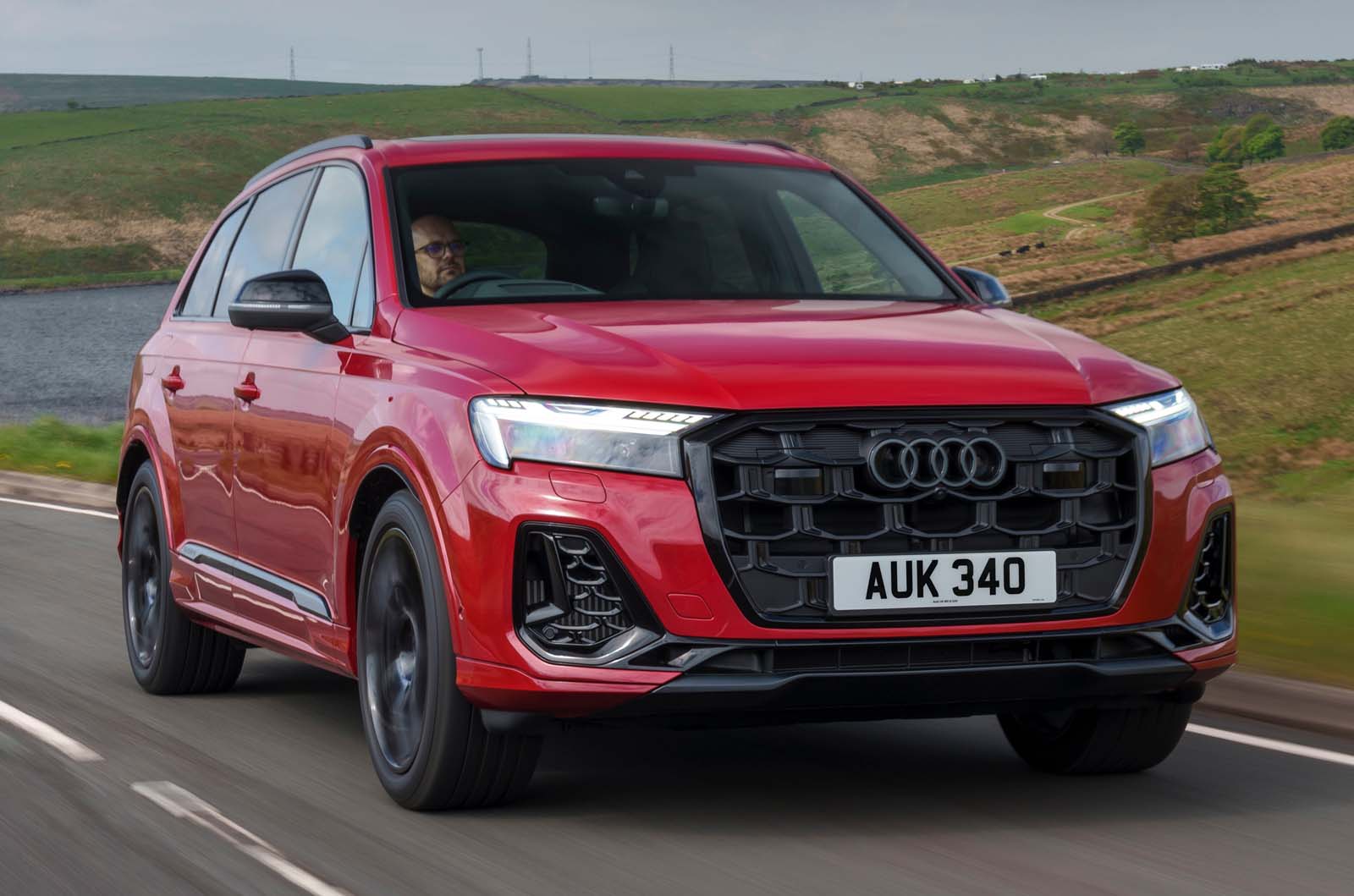
With a number of optional extras ticked, our test car came in at a hair over £80,000, making it cheaper than both the BMW X5 xDrive 50e and Range Rover Sport P460e.
Prices for the PHEV start from £77,865 but the diesels are even more competitive and undercut most of the Q7’s closest rivals.
A near 300-mile journey in the Q7 put its touring economy to the test with the big Audi achieving 32.5mpg in hybrid mode
Economy was a little more mixed, but there is no denying that the larger battery has helped improve the usability of Q7. Audi claims an EV range of up to 51 miles, but with the battery fully charged, we only ever saw 35-40 miles indicated – and that was during a week when temperatures were warmer than average.
Sure, that’s enough to go into town and back, but its real-word range is still some way short of that achieved by the BMW X5 xDrive50e (51 miles) or the Range Rover Sport P460e (55 miles),
With the two powertrains working in unison (and the battery fully charged) the Q7 will do 32-35mpg, and it’ll often do better on longer stints. Once the battery is flat though its much less frugal and you have to be pretty careful to get it close to 30mpg.
VERDICT
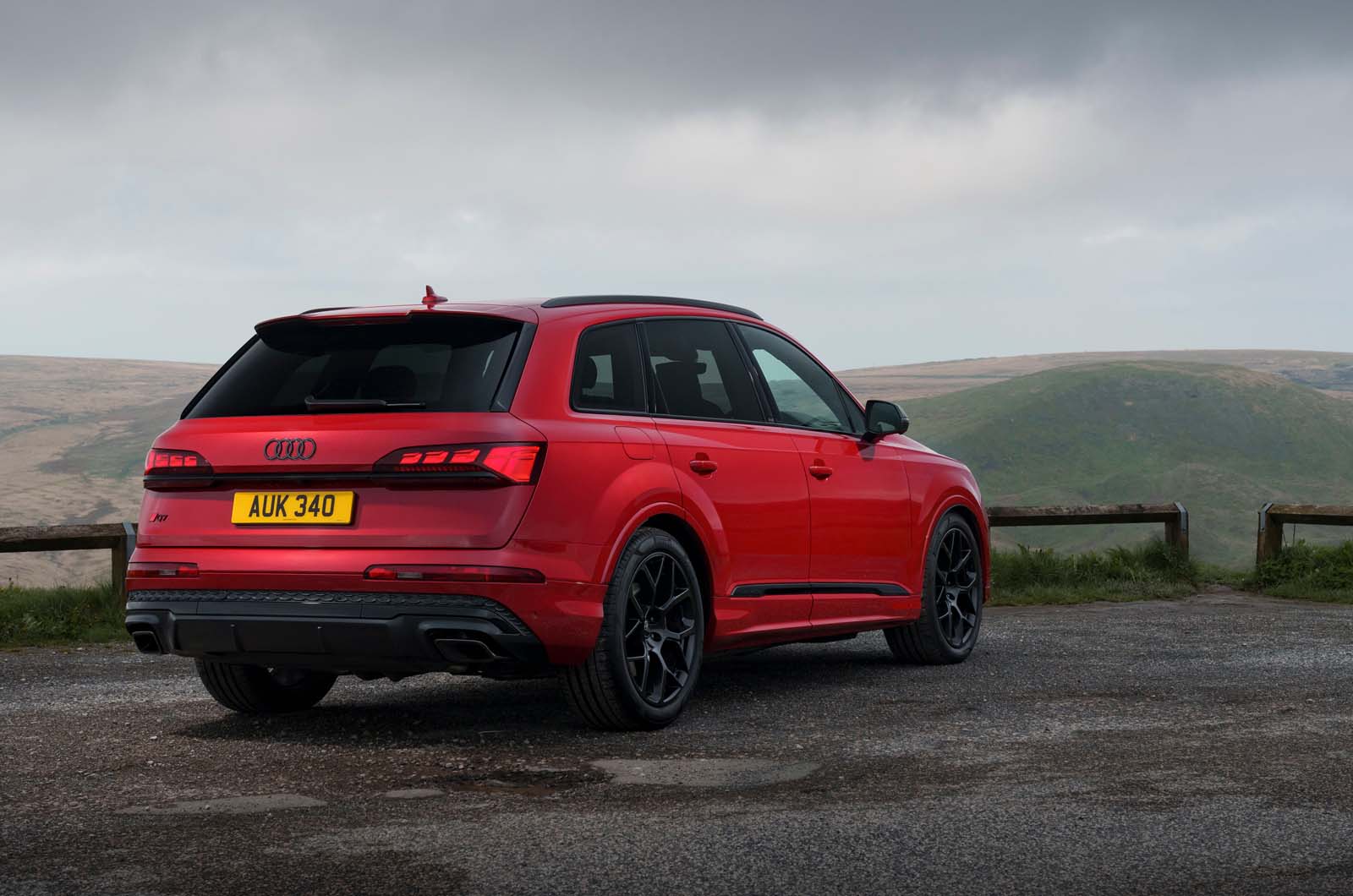
Verdict

Model tested:
Rating: 8
Audi Q7
Audi’s flagship SUV is as practical and refined as ever, but its PHEV credentials limit its capabilities as a large SUV
Good
Outstanding cabin refinement
Towering material quality
Roomier than most seven-seat SUVs
Bad
Remote, assistance-heavy steering
No handling finesse
PHEV range still can’t match rivals
Another facelift later, the Q7 remains a likeable, practicable and plush large SUV.
In plug-in hybrid form, it’s even heavier, and when the battery isn’t packed full of electrons it goes back to being a big, thirsty petrol SUV. And if you have no charger at home or work then the battery becomes more of a burden than a benefit.
That said, if you do have a charger in either of those locations, the 35-40 miles of EV range will come in handy for shorter trips and commutes, and the uptick in battery capacity over its predecessor has certainly improved the Q7’s flexibility.
But its closest rivlas can go further on a charge and can match its economy when the battery is flat.



